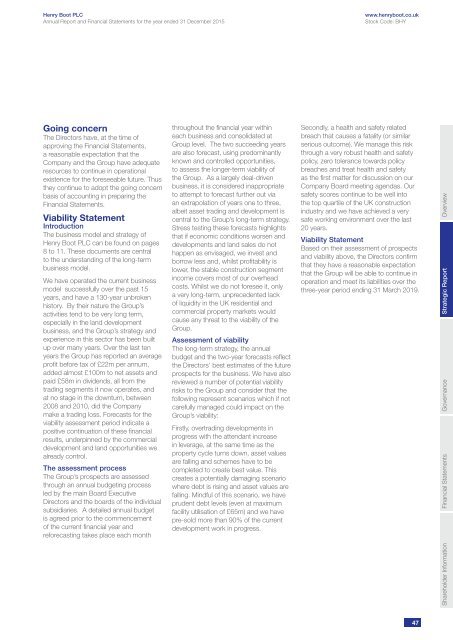Cohesive Consistent Confident
4mZ0Bv
4mZ0Bv
You also want an ePaper? Increase the reach of your titles
YUMPU automatically turns print PDFs into web optimized ePapers that Google loves.
Henry Boot PLC<br />
Annual Report and Financial Statements for the year ended 31 December 2015<br />
www.henryboot.co.uk<br />
Stock Code: BHY<br />
Going concern<br />
The Directors have, at the time of<br />
approving the Financial Statements,<br />
a reasonable expectation that the<br />
Company and the Group have adequate<br />
resources to continue in operational<br />
existence for the foreseeable future. Thus<br />
they continue to adopt the going concern<br />
basis of accounting in preparing the<br />
Financial Statements.<br />
Viability Statement<br />
Introduction<br />
The business model and strategy of<br />
Henry Boot PLC can be found on pages<br />
8 to 11. These documents are central<br />
to the understanding of the long-term<br />
business model.<br />
We have operated the current business<br />
model successfully over the past 15<br />
years, and have a 130-year unbroken<br />
history. By their nature the Group’s<br />
activities tend to be very long term,<br />
especially in the land development<br />
business, and the Group’s strategy and<br />
experience in this sector has been built<br />
up over many years. Over the last ten<br />
years the Group has reported an average<br />
profit before tax of £22m per annum,<br />
added almost £100m to net assets and<br />
paid £58m in dividends, all from the<br />
trading segments it now operates, and<br />
at no stage in the downturn, between<br />
2008 and 2010, did the Company<br />
make a trading loss. Forecasts for the<br />
viability assessment period indicate a<br />
positive continuation of these financial<br />
results, underpinned by the commercial<br />
development and land opportunities we<br />
already control.<br />
The assessment process<br />
The Group’s prospects are assessed<br />
through an annual budgeting process<br />
led by the main Board Executive<br />
Directors and the boards of the individual<br />
subsidiaries. A detailed annual budget<br />
is agreed prior to the commencement<br />
of the current financial year and<br />
reforecasting takes place each month<br />
throughout the financial year within<br />
each business and consolidated at<br />
Group level. The two succeeding years<br />
are also forecast, using predominantly<br />
known and controlled opportunities,<br />
to assess the longer-term viability of<br />
the Group. As a largely deal-driven<br />
business, it is considered inappropriate<br />
to attempt to forecast further out via<br />
an extrapolation of years one to three,<br />
albeit asset trading and development is<br />
central to the Group’s long-term strategy.<br />
Stress testing these forecasts highlights<br />
that if economic conditions worsen and<br />
developments and land sales do not<br />
happen as envisaged, we invest and<br />
borrow less and, whilst profitability is<br />
lower, the stable construction segment<br />
income covers most of our overhead<br />
costs. Whilst we do not foresee it, only<br />
a very long-term, unprecedented lack<br />
of liquidity in the UK residential and<br />
commercial property markets would<br />
cause any threat to the viability of the<br />
Group.<br />
Assessment of viability<br />
The long-term strategy, the annual<br />
budget and the two-year forecasts reflect<br />
the Directors’ best estimates of the future<br />
prospects for the business. We have also<br />
reviewed a number of potential viability<br />
risks to the Group and consider that the<br />
following represent scenarios which if not<br />
carefully managed could impact on the<br />
Group’s viability:<br />
Firstly, overtrading developments in<br />
progress with the attendant increase<br />
in leverage, at the same time as the<br />
property cycle turns down, asset values<br />
are falling and schemes have to be<br />
completed to create best value. This<br />
creates a potentially damaging scenario<br />
where debt is rising and asset values are<br />
falling. Mindful of this scenario, we have<br />
prudent debt levels (even at maximum<br />
facility utilisation of £65m) and we have<br />
pre-sold more than 90% of the current<br />
development work in progress.<br />
Secondly, a health and safety related<br />
breach that causes a fatality (or similar<br />
serious outcome). We manage this risk<br />
through a very robust health and safety<br />
policy, zero tolerance towards policy<br />
breaches and treat health and safety<br />
as the first matter for discussion on our<br />
Company Board meeting agendas. Our<br />
safety scores continue to be well into<br />
the top quartile of the UK construction<br />
industry and we have achieved a very<br />
safe working environment over the last<br />
20 years.<br />
Viability Statement<br />
Based on their assessment of prospects<br />
and viability above, the Directors confirm<br />
that they have a reasonable expectation<br />
that the Group will be able to continue in<br />
operation and meet its liabilities over the<br />
three-year period ending 31 March 2019.<br />
Shareholder Information Financial Statements<br />
Governance<br />
Strategic Report<br />
Overview<br />
47


